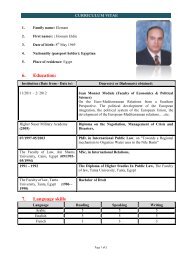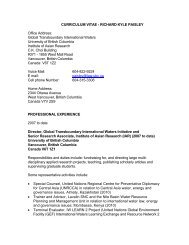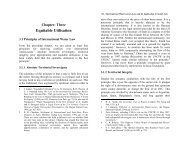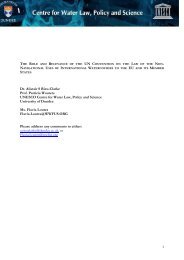Upreti, Trilochan, International Watercourses Law and Its Application ...
Upreti, Trilochan, International Watercourses Law and Its Application ...
Upreti, Trilochan, International Watercourses Law and Its Application ...
Create successful ePaper yourself
Turn your PDF publications into a flip-book with our unique Google optimized e-Paper software.
Introduction / 9 10 / <strong>International</strong> <strong>Watercourses</strong> <strong>Law</strong> <strong>and</strong> <strong>Its</strong> <strong>Application</strong> in South Asiapursuant to the provisions of the treaties. As a matter of fact,from these experiences Bhutan, Bangladesh <strong>and</strong> Nepal are verycautious in dealing with India with regards to sharing of thebenefits from these resources. The situation will be described inchapter four. The reasons are obvious, India <strong>and</strong> Nepal hadconcluded two treaties in the mid-1960’s, primarily forirrigation, flood control <strong>and</strong> miscellaneous purposes includingthe Kosi project <strong>and</strong> the G<strong>and</strong>ak project. The Nepalese people<strong>and</strong> the political parties alleged that these were carried outentirely for Indian benefit, ignoring Nepal's rights to theseresources. In other words, it was a ‘sell out’ of the naturalresources. 33 Similarly, due to the construction <strong>and</strong> operation ofthe Farakka barrage, at the border between India <strong>and</strong>Bangladesh, on the Ganges River, the barrage has causedsevere adverse impact to Bangladesh <strong>and</strong> planted the seeds ofdistrust <strong>and</strong> suspicion toward the former. Bhutan also appearsnot satisfied with the outcome of past agreement. As will bedescribed later, this project seriously caused adverse affects inBangladesh for a long time period. 34Water resources are the only substantial available naturalresources in this region besides coal <strong>and</strong> gas, <strong>and</strong> there is anurgent need to utilise these water resources expeditiously forthe benefit of the people of the region. There are bottleneckspreventing the achievement ofthis objective, which must be overcome by enhancing bilateralas well as regional co-operation. 3533 B. G.Verghese <strong>and</strong> R. R. Iyer (eds), Harnessing the EasternHimalayan Rivers: Regional Co-operation in South Asia, New Delhi:Konark Pub., 1993, pp. 200-2003; also see B. C. <strong>Upreti</strong>, The Politics ofHimalayan River Waters, New Delhi: Nirala Pub., 1993, pp. 98-118.34 M. Asfuddowalah, “Sharing of Tranboundary Rivers: The GangesTragedy” , M. I. Glassner, (ed), The United Nations at Work, WestportCT: Praeger, 1998, pp. 215-218.35 Supra note 27, pp. 390-393.1.4 Challenge AheadThis book aims to discuss <strong>and</strong> evaluate the present state ofIWL. It will also try to link the issue to Nepal's circumstances,in which water sharing <strong>and</strong> taking benefits therefrom must beaccording to the rules of international law. In principle,international law is equally applicable to all nations. In practice,economically weak nations, such as Nepal or Ethiopia aretreated unequally. For instance, Egypt is able to use mostportions of the waters in the Nile, at the same time, Ethiopiahaving significantly contributing waters in Blue Nile (maintributary of the Nile), is prohibited from using its equitableshare of waters in the same river by the objections <strong>and</strong> threatsof former. In a similar way, Nepal is not able to use its ownshare of water because of Indian objections stating that suchnew use would impair its prior use. India has developed theFarakka barrage. Egypt developed the Aswan dam (with SovietUnion support). China is developing the Three Gorges projectsfrom its own resources, in spite of severe criticism frominternational spheres. 36 Of course, dams are often criticised forpolitical <strong>and</strong> environmental considerations unrelated to riparianissues. In these cases international assistance has not beenforthcoming. <strong>International</strong> cooperation has not been provided toenable the implementation of projects for example in thefollowing cases, Narmada in India, <strong>and</strong> the Southern Antoliaproject in Turkey. There is also a current conflict over theongoing supply of drinking waters from Malaysia to Singapore.In order to develop such water projects, poor countries do nothave resources, they need international or bilateral co-operationin money, technology <strong>and</strong> skilled manpower. Foreign donorsseek clearance from other riparian states <strong>and</strong> these riparianstates object to such a project stating it will affect themadversely. In many cases, donors cancel funding. Therefore, aweak <strong>and</strong> poor country does not have its own resources <strong>and</strong>36 www.internationalwaterlaw.org "Three Gorges Dam". Dams are notconsidered to be a part of sustainable development because of theiradverse affect on ecology <strong>and</strong> indigenous people.












